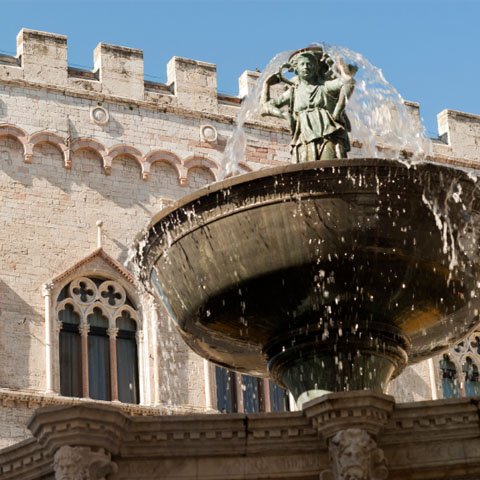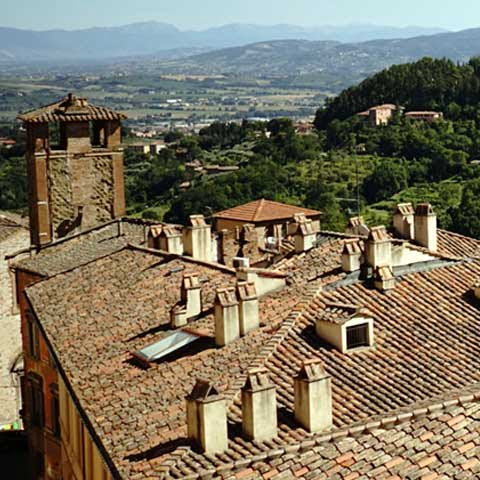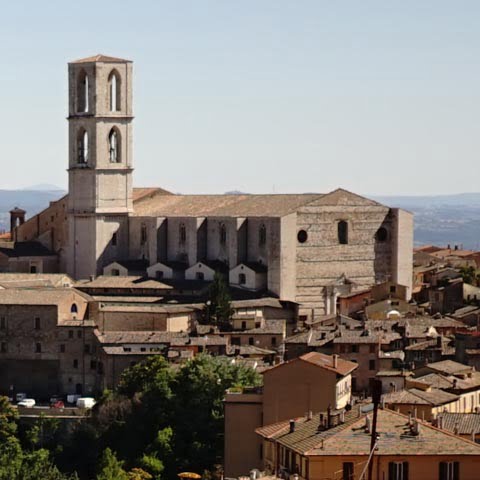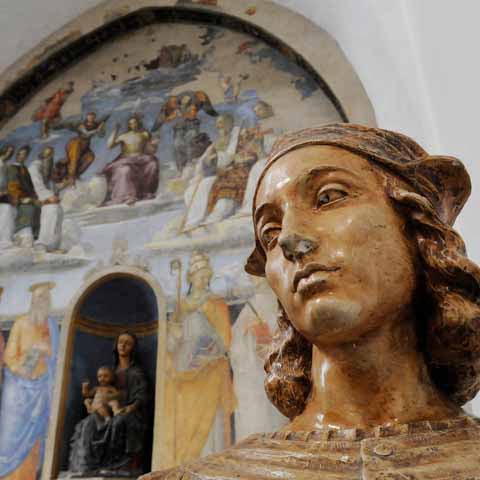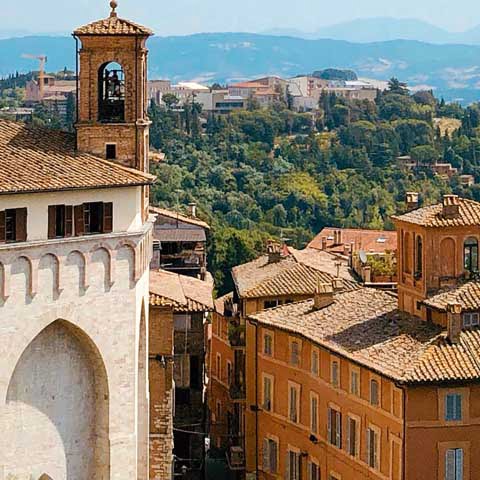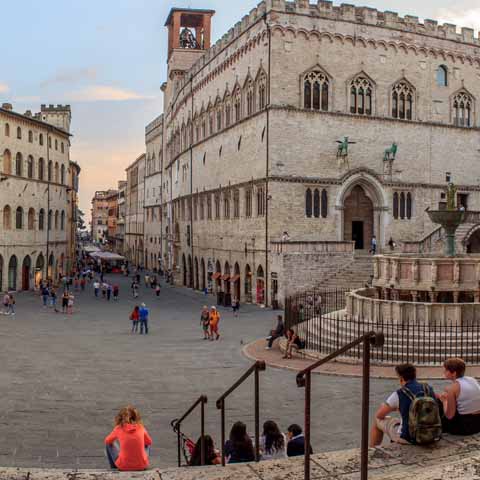The city of Perugia is the capital of the Central Italian region of Umbria. Much of this beautiful city is built on a hill, which provides breathtaking views of the city itself as well as the surrounding Umbrian countryside. Although Perugia is not as well traveled as some Italian powerhouse cities such as Rome or Florence, that elusiveness is part of what adds to its charm.
The city itself is often referred to in two main parts, the old town located on the hill and the more modern city that sits below. Regardless of where you wander in Perugia, beauty abounds in every cobblestone street, historical piazza, and more. Visitors to the city say they particularly enjoy walking the scenic streets and narrow alleyways that wind up and down the hill for a one-of-a-kind quintessential Perugia experience.
The town’s pedestrian avenues and major squares are considered to be main gathering areas for locals and visitors alike. While these areas are quite active for most of the day, there is said to be something special about the hour of dusk when the glow of the sunset mingles with the charming evening lights of the city. The streets are often most crowded during the evening passegiatta just before dinner. Not to be missed as you stroll about town are the main streets of Corso Vannucci, Via Oberdan, the piazze, the Fontana Maggiore, the aqueduct walkway, and the Cathedral of San Lorenzo.
One of the most striking characteristics of this town is the blend of the traditional and modern parts of Perugia. The older part of town is full of history that can be traced all the way back to 300 BC. Originally, Perugia is thought to have been occupied by the Etruscans before they were conquered by the Romans. The barbarians eventually conquered Perugia after the Romans, then the city experienced a few more political scuffles over the years as it rose to become a regional power. Eventually, the Popes became enthralled with the city and largely took it over for a time until the Unification of Italy in the mid-nineteenth century.
One of the most notable historical contributions is the establishment of the University of Perugia. This public educational institution was founded in the early fourteenth century and is estimated to serve approximately thirty thousand students and employ more than one thousand staff members today. In addition to being one of the most prominent universities in the region, it is one of the oldest in Italy.
Also in Perugia is the University for Foreigners, which was originally established as a language school to teach foreigners Italian, but has now expanded to include a variety of bachelor’s and master’s level degree programs. With the amazing educational offerings this gorgeous city has, it is not surprising that almost a quarter of the town’s population can be attributed to college students.
The nightlife of Perugia is alive and well with many saying it is the time when the town really comes alive. The streets of the city are often crowded after darkness falls with people wandering about to stroll, dine, or take in an impromptu musical performance in one of the piazze.
For those traveling to Perugia by air, the closest international airports are in Florence and Rome. For those not needing to cross an ocean to arrive in Perugia, rail lines or highways may be a good bet. A state railway connects the city with Rome and Florence, while three main highways intersect with Perugia including the Raccordo Perugia A-1, the E45, and the SS75bis. For those with cars, the city does have several parking areas.
When it comes to navigating the city itself, there are both pedestrian and automobile areas. That said, much of the historic city center is a pedestrian zone. With the city being so compact, it can easily and joyfully be explored on foot. This particularly comes in handy when planning to use the escalators to access the Mini Metro subway rail line in the city.
GEOGRAPHY
The region of Umbria is centrally located within the country of Italy. Tucked within Umbria is the city of Perugia which also serves as its capital. The city is within roughly one hundred miles of Rome and because it is so central it is often a great home base location for a number of day trips to nearby places such as Assisi and Siena.
Perugia is surrounded by the picturesque Umbrian countryside which is largely rural and green and dotted with beautiful trees and winding country roads. Because the city is partially located on a hill, at some of the highest points or landmarks, visitors can take in amazing views of the lower city and distant countryside.
CLIMATE IN PERUGIA
The summer is a fabulous time to visit Perugia. With average highs hovering in the eighties (in degrees Fahrenheit) and average lows bottoming out in the sixties, the weather is fairly comfortable and makes traveling the city on foot a delight.
The fall months in Perugia become increasingly cooler as it nears the winter season. Fall typically brings average temperatures of highs in the sixties with lows in the forties. While it is cooler than the summer, temperatures still lend themselves to exploring Perugia.
In winter, the area becomes colder with average highs only reaching the upper forties and the average lows bottoming out in the mid to low thirties. With a cup of hot chocolate and the right winter outerwear, a winter trip to Perugia is certainly not out of the question.
Spring in the city is a gradual thaw that generally starts in March and concludes in May. Temperatures at the start of the season are usually at an average high in the fifties and a low in the thirties. However, as summer approaches, May temperatures typically reach the seventies for a high and bottom out in the upper forties.
Rainfall throughout the year is fairly light with an average of a couple of inches falling each month. Fall and winter seasons tend to see slightly more rainfall than the remainder of the year.
ONLY IN PERUGIA
One of the most unique structures in Perugia is Rocca Paolina. Although not the first fortress to be built in the area, it is one of the best known. Estimated to have been built in the first half of the sixteenth century, the construction of the fortress is said to have negatively affected nearby historical buildings and in effect put much of the city’s ancient streets of the city center into what are now underground passageways open to the public. Despite its troubled political past, today the Rocca Paolina is often used as a commuting route to the bus station by locals and visitors. It is also frequently the site of holiday exhibits and cultural events. Do not miss the opportunity to wander the underground city and dungeons of the fortress. Regardless of where you travel within Rocca Paolina, treasures abound in almost every corner.
Perugia has a strong artistic and cultural tradition. It was home to painters and masters such as Pinturicchio, Vannucci, Fra Angelico, and Piero della Francesca. While strolling around the city, visitors meet the dramatic architecture of the Basilica of San Pietro, the Great Fountain with scenes of Old Testament, and interesting historical palaces.
The National gallery is stunning and displays art from the thirteenth to the nineteenth century by renowned artists such as Giovanni Pisano and Duccio di Boninsegna. Collegio del Cambio, Collegio della Mercanzia and the Sala dei Notari are other museums that should not be missed. History lovers should stop by the Archeological Museum, venture down into the third century BC Pozzo Etrusco (Etruscan Well), and explore the several churches that dot the city: the Chapel of San Severo, the Church of Sant’Agostino, the Church of San Domenico and many others, all of them full of works of art.
As the capital of the region, Perugia serves as a gateway to Umbria. During a trip to the city, travelers can enjoy Perugia’s history, architecture, and art as well as the countryside charms of the verdant Umbria region.
Don't just see Italy, live it.
Your dream trip to Italy has never been closer
No more endlessly scrolling travel sites. Our travel experts will craft the perfect, one-of-a-kind trip just for you.

300+
DESTINATIONS
We offer more Italian destinations than any travel site. Do and see more with Trips 2 Italy.
1 (of a kind)
ITINERARIES
Because your dream trip to Italy should be designed for you, not for the masses.
100%
PEACE OF MIND
From flights and accommodations, to food and activities - we take care of every detail.
